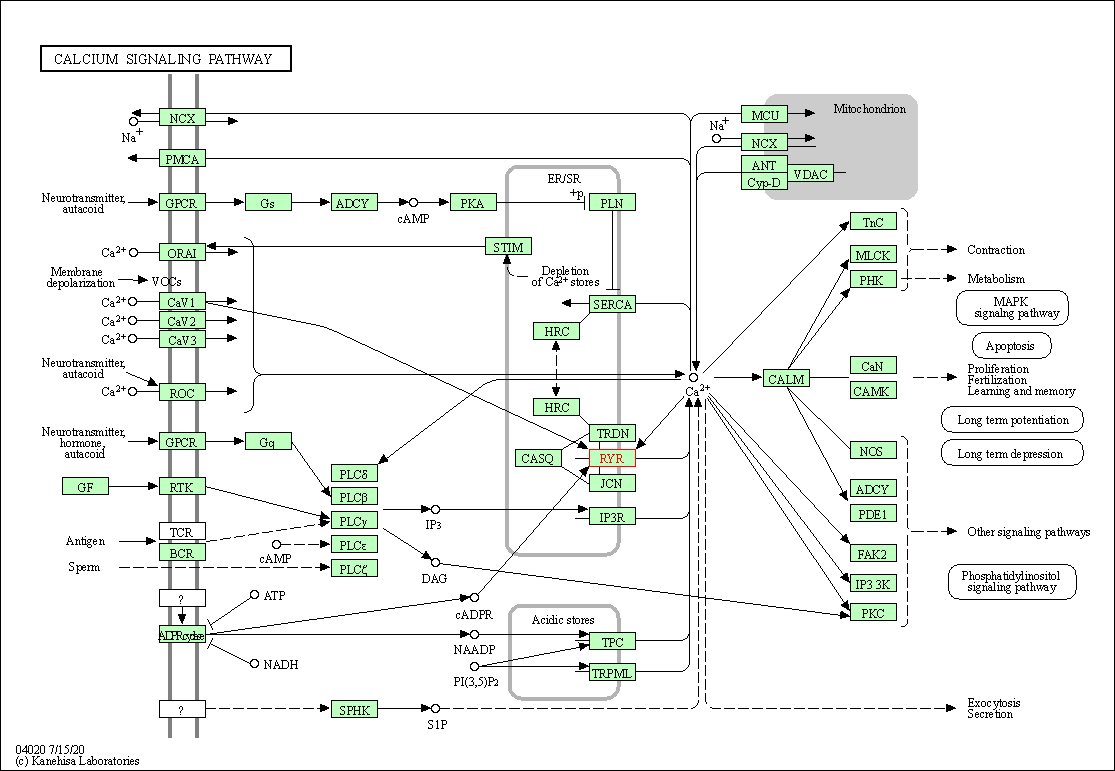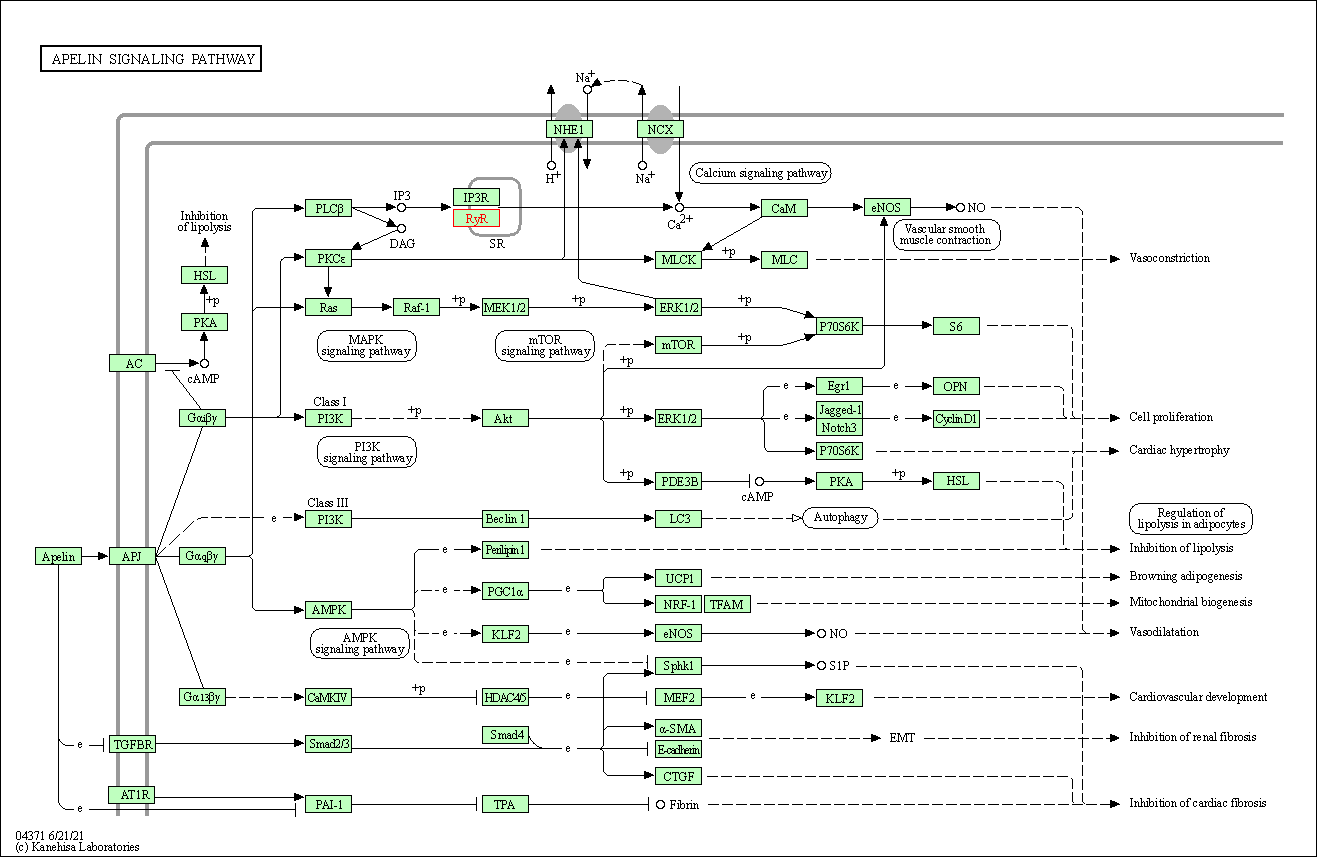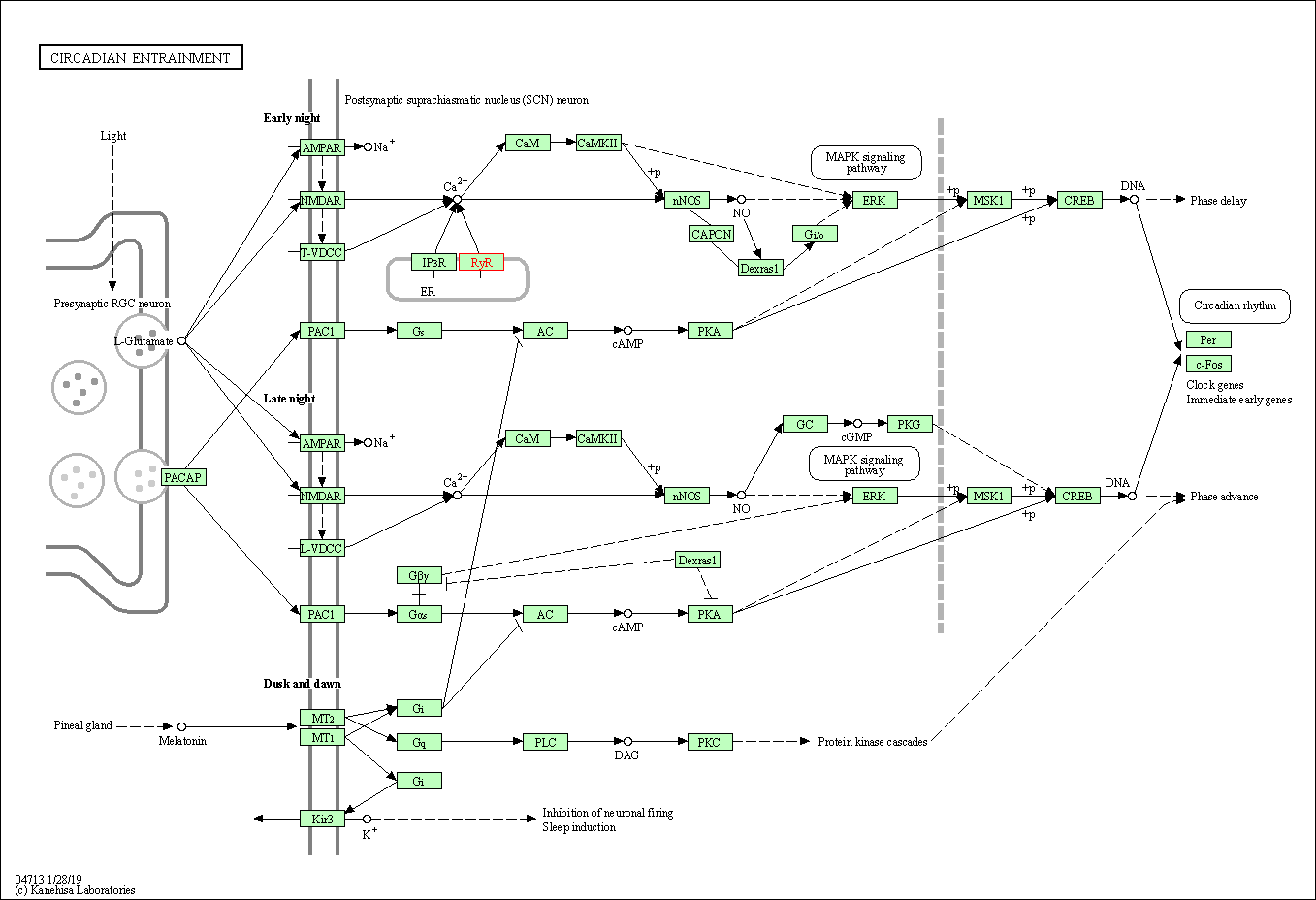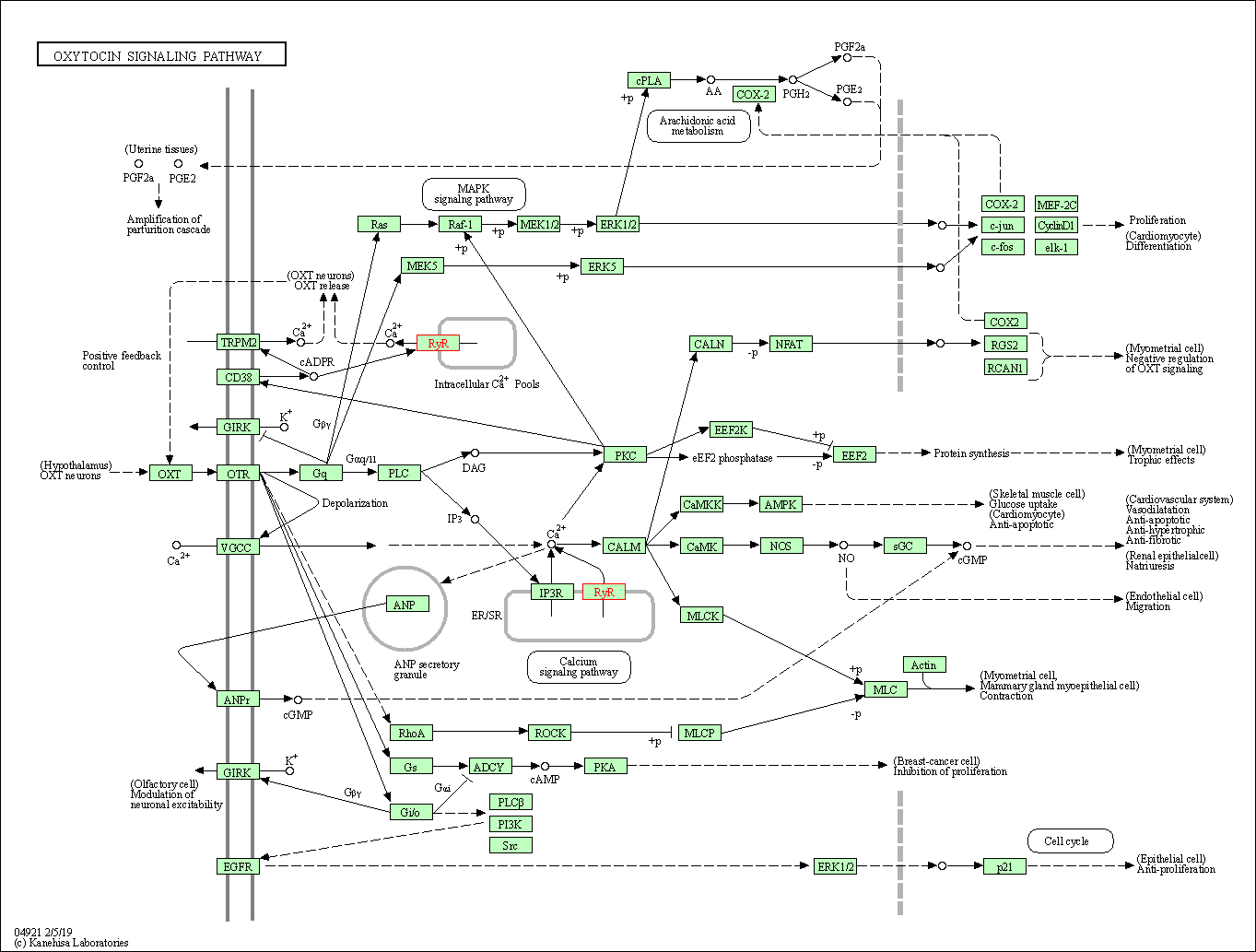Target Information
| Target General Information | Top | |||||
|---|---|---|---|---|---|---|
| Target ID |
T92328
(Former ID: TTDS00165)
|
|||||
| Target Name |
Ryanodine receptor 1 (RYR1)
|
|||||
| Synonyms |
Type 1 ryanodine receptor; Skeletal muscle-type ryanodine receptor; Skeletal muscle ryanodine receptor; Skeletal muscle calcium release channel; RyR1; RyR; RYR-1; RYDR; Cardiac muscleryanodine receptor-calcium release channel; Cardiac muscle-type ryanodine receptor; Brain-type ryanodine receptor; Brain ryanodine receptor-calcium release channel
Click to Show/Hide
|
|||||
| Gene Name |
RYR1
|
|||||
| Target Type |
Discontinued target
|
[1] | ||||
| Disease | [+] 1 Target-related Diseases | + | ||||
| 1 | Heart failure [ICD-11: BD10-BD1Z] | |||||
| Function |
Repeated very high-level exercise increases the open probability of the channel and leads to Ca(2+) leaking into the cytoplasm. Can also mediate the release of Ca(2+) from intracellular stores in neurons, and may thereby promote prolonged Ca(2+) signaling in the brain. Required for normal embryonic development of muscle fibers and skeletal muscle. Required for normal heart morphogenesis, skin development and ossification during embryogenesis. Calcium channel that mediates the release of Ca(2+) from the sarcoplasmic reticulum into the cytoplasm and thereby plays a key role in triggering muscle contraction following depolarization of T-tubules.
Click to Show/Hide
|
|||||
| BioChemical Class |
Ryanodine-inositol 1,4,5-triphosphate receptor calcium channel
|
|||||
| UniProt ID | ||||||
| Sequence |
MGDAEGEDEVQFLRTDDEVVLQCSATVLKEQLKLCLAAEGFGNRLCFLEPTSNAQNVPPD
LAICCFVLEQSLSVRALQEMLANTVEAGVESSQGGGHRTLLYGHAILLRHAHSRMYLSCL TTSRSMTDKLAFDVGLQEDATGEACWWTMHPASKQRSEGEKVRVGDDIILVSVSSERYLH LSTASGELQVDASFMQTLWNMNPICSRCEEGFVTGGHVLRLFHGHMDECLTISPADSDDQ RRLVYYEGGAVCTHARSLWRLEPLRISWSGSHLRWGQPLRVRHVTTGQYLALTEDQGLVV VDASKAHTKATSFCFRISKEKLDVAPKRDVEGMGPPEIKYGESLCFVQHVASGLWLTYAA PDPKALRLGVLKKKAMLHQEGHMDDALSLTRCQQEESQAARMIHSTNGLYNQFIKSLDSF SGKPRGSGPPAGTALPIEGVILSLQDLIIYFEPPSEDLQHEEKQSKLRSLRNRQSLFQEE GMLSMVLNCIDRLNVYTTAAHFAEFAGEEAAESWKEIVNLLYELLASLIRGNRSNCALFS TNLDWLVSKLDRLEASSGILEVLYCVLIESPEVLNIIQENHIKSIISLLDKHGRNHKVLD VLCSLCVCNGVAVRSNQDLITENLLPGRELLLQTNLINYVTSIRPNIFVGRAEGTTQYSK WYFEVMVDEVTPFLTAQATHLRVGWALTEGYTPYPGAGEGWGGNGVGDDLYSYGFDGLHL WTGHVARPVTSPGQHLLAPEDVISCCLDLSVPSISFRINGCPVQGVFESFNLDGLFFPVV SFSAGVKVRFLLGGRHGEFKFLPPPGYAPCHEAVLPRERLHLEPIKEYRREGPRGPHLVG PSRCLSHTDFVPCPVDTVQIVLPPHLERIREKLAENIHELWALTRIEQGWTYGPVRDDNK RLHPCLVDFHSLPEPERNYNLQMSGETLKTLLALGCHVGMADEKAEDNLKKTKLPKTYMM SNGYKPAPLDLSHVRLTPAQTTLVDRLAENGHNVWARDRVGQGWSYSAVQDIPARRNPRL VPYRLLDEATKRSNRDSLCQAVRTLLGYGYNIEPPDQEPSQVENQSRCDRVRIFRAEKSY TVQSGRWYFEFEAVTTGEMRVGWARPELRPDVELGADELAYVFNGHRGQRWHLGSEPFGR PWQPGDVVGCMIDLTENTIIFTLNGEVLMSDSGSETAFREIEIGDGFLPVCSLGPGQVGH LNLGQDVSSLRFFAICGLQEGFEPFAINMQRPVTTWFSKGLPQFEPVPLEHPHYEVSRVD GTVDTPPCLRLTHRTWGSQNSLVEMLFLRLSLPVQFHQHFRCTAGATPLAPPGLQPPAED EARAAEPDPDYENLRRSAGGWSEAENGKEGTAKEGAPGGTPQAGGEAQPARAENEKDATT EKNKKRGFLFKAKKVAMMTQPPATPTLPRLPHDVVPADNRDDPEIILNTTTYYYSVRVFA GQEPSCVWAGWVTPDYHQHDMSFDLSKVRVVTVTMGDEQGNVHSSLKCSNCYMVWGGDFV SPGQQGRISHTDLVIGCLVDLATGLMTFTANGKESNTFFQVEPNTKLFPAVFVLPTHQNV IQFELGKQKNIMPLSAAMFQSERKNPAPQCPPRLEMQMLMPVSWSRMPNHFLQVETRRAG ERLGWAVQCQEPLTMMALHIPEENRCMDILELSERLDLQRFHSHTLRLYRAVCALGNNRV AHALCSHVDQAQLLHALEDAHLPGPLRAGYYDLLISIHLESACRSRRSMLSEYIVPLTPE TRAITLFPPGRSTENGHPRHGLPGVGVTTSLRPPHHFSPPCFVAALPAAGAAEAPARLSP AIPLEALRDKALRMLGEAVRDGGQHARDPVGGSVEFQFVPVLKLVSTLLVMGIFGDEDVK QILKMIEPEVFTEEEEEEDEEEEGEEEDEEEKEEDEEETAQEKEDEEKEEEEAAEGEKEE GLEEGLLQMKLPESVKLQMCHLLEYFCDQELQHRVESLAAFAERYVDKLQANQRSRYGLL IKAFSMTAAETARRTREFRSPPQEQINMLLQFKDGTDEEDCPLPEEIRQDLLDFHQDLLA HCGIQLDGEEEEPEEETTLGSRLMSLLEKVRLVKKKEEKPEEERSAEESKPRSLQELVSH MVVRWAQEDFVQSPELVRAMFSLLHRQYDGLGELLRALPRAYTISPSSVEDTMSLLECLG QIRSLLIVQMGPQEENLMIQSIGNIMNNKVFYQHPNLMRALGMHETVMEVMVNVLGGGES KEIRFPKMVTSCCRFLCYFCRISRQNQRSMFDHLSYLLENSGIGLGMQGSTPLDVAAASV IDNNELALALQEQDLEKVVSYLAGCGLQSCPMLVAKGYPDIGWNPCGGERYLDFLRFAVF VNGESVEENANVVVRLLIRKPECFGPALRGEGGSGLLAAIEEAIRISEDPARDGPGIRRD RRREHFGEEPPEENRVHLGHAIMSFYAALIDLLGRCAPEMHLIQAGKGEALRIRAILRSL VPLEDLVGIISLPLQIPTLGKDGALVQPKMSASFVPDHKASMVLFLDRVYGIENQDFLLH VLDVGFLPDMRAAASLDTATFSTTEMALALNRYLCLAVLPLITKCAPLFAGTEHRAIMVD SMLHTVYRLSRGRSLTKAQRDVIEDCLMSLCRYIRPSMLQHLLRRLVFDVPILNEFAKMP LKLLTNHYERCWKYYCLPTGWANFGVTSEEELHLTRKLFWGIFDSLAHKKYDPELYRMAM PCLCAIAGALPPDYVDASYSSKAEKKATVDAEGNFDPRPVETLNVIIPEKLDSFINKFAE YTHEKWAFDKIQNNWSYGENIDEELKTHPMLRPYKTFSEKDKEIYRWPIKESLKAMIAWE WTIEKAREGEEEKTEKKKTRKISQSAQTYDPREGYNPQPPDLSAVTLSRELQAMAEQLAE NYHNTWGRKKKQELEAKGGGTHPLLVPYDTLTAKEKARDREKAQELLKFLQMNGYAVTRG LKDMELDSSSIEKRFAFGFLQQLLRWMDISQEFIAHLEAVVSSGRVEKSPHEQEIKFFAK ILLPLINQYFTNHCLYFLSTPAKVLGSGGHASNKEKEMITSLFCKLAALVRHRVSLFGTD APAVVNCLHILARSLDARTVMKSGPEIVKAGLRSFFESASEDIEKMVENLRLGKVSQART QVKGVGQNLTYTTVALLPVLTTLFQHIAQHQFGDDVILDDVQVSCYRTLCSIYSLGTTKN TYVEKLRPALGECLARLAAAMPVAFLEPQLNEYNACSVYTTKSPRERAILGLPNSVEEMC PDIPVLERLMADIGGLAESGARYTEMPHVIEITLPMLCSYLPRWWERGPEAPPSALPAGA PPPCTAVTSDHLNSLLGNILRIIVNNLGIDEASWMKRLAVFAQPIVSRARPELLQSHFIP TIGRLRKRAGKVVSEEEQLRLEAKAEAQEGELLVRDEFSVLCRDLYALYPLLIRYVDNNR AQWLTEPNPSAEELFRMVGEIFIYWSKSHNFKREEQNFVVQNEINNMSFLTADNKSKMAK AGDIQSGGSDQERTKKKRRGDRYSVQTSLIVATLKKMLPIGLNMCAPTDQDLITLAKTRY ALKDTDEEVREFLHNNLHLQGKVEGSPSLRWQMALYRGVPGREEDADDPEKIVRRVQEVS AVLYYLDQTEHPYKSKKAVWHKLLSKQRRRAVVACFRMTPLYNLPTHRACNMFLESYKAA WILTEDHSFEDRMIDDLSKAGEQEEEEEEVEEKKPDPLHQLVLHFSRTALTEKSKLDEDY LYMAYADIMAKSCHLEEGGENGEAEEEVEVSFEEKQMEKQRLLYQQARLHTRGAAEMVLQ MISACKGETGAMVSSTLKLGISILNGGNAEVQQKMLDYLKDKKEVGFFQSIQALMQTCSV LDLNAFERQNKAEGLGMVNEDGTVINRQNGEKVMADDEFTQDLFRFLQLLCEGHNNDFQN YLRTQTGNTTTINIIICTVDYLLRLQESISDFYWYYSGKDVIEEQGKRNFSKAMSVAKQV FNSLTEYIQGPCTGNQQSLAHSRLWDAVVGFLHVFAHMMMKLAQDSSQIELLKELLDLQK DMVVMLLSLLEGNVVNGMIARQMVDMLVESSSNVEMILKFFDMFLKLKDIVGSEAFQDYV TDPRGLISKKDFQKAMDSQKQFSGPEIQFLLSCSEADENEMINCEEFANRFQEPARDIGF NVAVLLTNLSEHVPHDPRLHNFLELAESILEYFRPYLGRIEIMGASRRIERIYFEISETN RAQWEMPQVKESKRQFIFDVVNEGGEAEKMELFVSFCEDTIFEMQIAAQISEPEGEPETD EDEGAGAAEAGAEGAEEGAAGLEGTAATAAAGATARVVAAAGRALRGLSYRSLRRRVRRL RRLTAREAATAVAALLWAAVTRAGAAGAGAAAGALGLLWGSLFGGGLVEGAKKVTVTELL AGMPDPTSDEVHGEQPAGPGGDADGEGASEGAGDAAEGAGDEEEAVHEAGPGGADGAVAV TDGGPFRPEGAGGLGDMGDTTPAEPPTPEGSPILKRKLGVDGVEEELPPEPEPEPEPELE PEKADAENGEKEEVPEPTPEPPKKQAPPSPPPKKEEAGGEFWGELEVQRVKFLNYLSRNF YTLRFLALFLAFAINFILLFYKVSDSPPGEDDMEGSAAGDVSGAGSGGSSGWGLGAGEEA EGDEDENMVYYFLEESTGYMEPALRCLSLLHTLVAFLCIIGYNCLKVPLVIFKREKELAR KLEFDGLYITEQPEDDDVKGQWDRLVLNTPSFPSNYWDKFVKRKVLDKHGDIYGRERIAE LLGMDLATLEITAHNERKPNPPPGLLTWLMSIDVKYQIWKFGVIFTDNSFLYLGWYMVMS LLGHYNNFFFAAHLLDIAMGVKTLRTILSSVTHNGKQLVMTVGLLAVVVYLYTVVAFNFF RKFYNKSEDEDEPDMKCDDMMTCYLFHMYVGVRAGGGIGDEIEDPAGDEYELYRVVFDIT FFFFVIVILLAIIQGLIIDAFGELRDQQEQVKEDMETKCFICGIGSDYFDTTPHGFETHT LEEHNLANYMFFLMYLINKDETEHTGQESYVWKMYQERCWDFFPAGDCFRKQYEDQLS Click to Show/Hide
|
|||||
| HIT2.0 ID | T84VZG | |||||
| Drugs and Modes of Action | Top | |||||
|---|---|---|---|---|---|---|
| Discontinued Drug(s) | [+] 2 Discontinued Drugs | + | ||||
| 1 | ARM036 | Drug Info | Discontinued in Phase 2 | Heart failure | [2] | |
| 2 | CDP-1050 | Drug Info | Discontinued in Phase 1 | Heart failure | [3] | |
| Mode of Action | [+] 3 Modes of Action | + | ||||
| Modulator | [+] 2 Modulator drugs | + | ||||
| 1 | ARM036 | Drug Info | [1] | |||
| 2 | CDP-1050 | Drug Info | [1] | |||
| Inhibitor | [+] 8 Inhibitor drugs | + | ||||
| 1 | (O10eq)-beta-alanyl-anhydro-ryanodine | Drug Info | [4] | |||
| 2 | (O10eq)-beta-alanylryanodine | Drug Info | [4] | |||
| 3 | (O10eq)-beta-guanidinopropionylryanodine | Drug Info | [4] | |||
| 4 | (O10eq)-guanidino acetylryanodine | Drug Info | [4] | |||
| 5 | Benzyloxycarbonyl-glycylryanodine | Drug Info | [4] | |||
| 6 | Di-Benzyloxycarbonyl-guanidino acetylryanodine | Drug Info | [4] | |||
| 7 | GLYCYLRYANODINE | Drug Info | [4] | |||
| 8 | N-methyl ryanodine-succinamidate | Drug Info | [4] | |||
| Antagonist | [+] 2 Antagonist drugs | + | ||||
| 1 | Ruthenium red | Drug Info | [5] | |||
| 2 | Ryanodine | Drug Info | [6] | |||
| Cell-based Target Expression Variations | Top | |||||
|---|---|---|---|---|---|---|
| Cell-based Target Expression Variations | ||||||
| Different Human System Profiles of Target | Top |
|---|---|
|
Human Similarity Proteins
of target is determined by comparing the sequence similarity of all human proteins with the target based on BLAST. The similarity proteins for a target are defined as the proteins with E-value < 0.005 and outside the protein families of the target.
A target that has fewer human similarity proteins outside its family is commonly regarded to possess a greater capacity to avoid undesired interactions and thus increase the possibility of finding successful drugs
(Brief Bioinform, 21: 649-662, 2020).
Human Tissue Distribution
of target is determined from a proteomics study that quantified more than 12,000 genes across 32 normal human tissues. Tissue Specificity (TS) score was used to define the enrichment of target across tissues.
The distribution of targets among different tissues or organs need to be taken into consideration when assessing the target druggability, as it is generally accepted that the wider the target distribution, the greater the concern over potential adverse effects
(Nat Rev Drug Discov, 20: 64-81, 2021).
Human Pathway Affiliation
of target is determined by the life-essential pathways provided on KEGG database. The target-affiliated pathways were defined based on the following two criteria (a) the pathways of the studied target should be life-essential for both healthy individuals and patients, and (b) the studied target should occupy an upstream position in the pathways and therefore had the ability to regulate biological function.
Targets involved in a fewer pathways have greater likelihood to be successfully developed, while those associated with more human pathways increase the chance of undesirable interferences with other human processes
(Pharmacol Rev, 58: 259-279, 2006).
Biological Network Descriptors
of target is determined based on a human protein-protein interactions (PPI) network consisting of 9,309 proteins and 52,713 PPIs, which were with a high confidence score of ≥ 0.95 collected from STRING database.
The network properties of targets based on protein-protein interactions (PPIs) have been widely adopted for the assessment of target’s druggability. Proteins with high node degree tend to have a high impact on network function through multiple interactions, while proteins with high betweenness centrality are regarded to be central for communication in interaction networks and regulate the flow of signaling information
(Front Pharmacol, 9, 1245, 2018;
Curr Opin Struct Biol. 44:134-142, 2017).
Human Similarity Proteins
Human Tissue Distribution
Human Pathway Affiliation
Biological Network Descriptors
|
|
|
There is no similarity protein (E value < 0.005) for this target
|
|
Note:
If a protein has TS (tissue specficity) scores at least in one tissue >= 2.5, this protein is called tissue-enriched (including tissue-enriched-but-not-specific and tissue-specific). In the plots, the vertical lines are at thresholds 2.5 and 4.
|
| KEGG Pathway | Pathway ID | Affiliated Target | Pathway Map |
|---|---|---|---|
| Calcium signaling pathway | hsa04020 | Affiliated Target |

|
| Class: Environmental Information Processing => Signal transduction | Pathway Hierarchy | ||
| Apelin signaling pathway | hsa04371 | Affiliated Target |

|
| Class: Environmental Information Processing => Signal transduction | Pathway Hierarchy | ||
| Circadian entrainment | hsa04713 | Affiliated Target |

|
| Class: Organismal Systems => Environmental adaptation | Pathway Hierarchy | ||
| Long-term depression | hsa04730 | Affiliated Target |

|
| Class: Organismal Systems => Nervous system | Pathway Hierarchy | ||
| Oxytocin signaling pathway | hsa04921 | Affiliated Target |

|
| Class: Organismal Systems => Endocrine system | Pathway Hierarchy | ||
| Degree | 12 | Degree centrality | 1.29E-03 | Betweenness centrality | 1.25E-03 |
|---|---|---|---|---|---|
| Closeness centrality | 1.93E-01 | Radiality | 1.33E+01 | Clustering coefficient | 1.36E-01 |
| Neighborhood connectivity | 8.00E+00 | Topological coefficient | 1.25E-01 | Eccentricity | 12 |
| Download | Click to Download the Full PPI Network of This Target | ||||
| Chemical Structure based Activity Landscape of Target | Top |
|---|---|
| Drug Property Profile of Target | Top | |
|---|---|---|
| (1) Molecular Weight (mw) based Drug Clustering | (2) Octanol/Water Partition Coefficient (xlogp) based Drug Clustering | |
|
|
||
| (3) Hydrogen Bond Donor Count (hbonddonor) based Drug Clustering | (4) Hydrogen Bond Acceptor Count (hbondacc) based Drug Clustering | |
|
|
||
| (5) Rotatable Bond Count (rotbonds) based Drug Clustering | (6) Topological Polar Surface Area (polararea) based Drug Clustering | |
|
|
||
| "RO5" indicates the cutoff set by lipinski's rule of five; "D123AB" colored in GREEN denotes the no violation of any cutoff in lipinski's rule of five; "D123AB" colored in PURPLE refers to the violation of only one cutoff in lipinski's rule of five; "D123AB" colored in BLACK represents the violation of more than one cutoffs in lipinski's rule of five | ||
| Target Poor or Non Binders | Top | |||||
|---|---|---|---|---|---|---|
| Target Poor or Non Binders | ||||||
| Target Regulators | Top | |||||
|---|---|---|---|---|---|---|
| Target-interacting Proteins | ||||||
| Target Affiliated Biological Pathways | Top | |||||
|---|---|---|---|---|---|---|
| Panther Pathway | [+] 3 Panther Pathways | + | ||||
| 1 | Beta1 adrenergic receptor signaling pathway | |||||
| 2 | Beta2 adrenergic receptor signaling pathway | |||||
| 3 | CCKR signaling map ST | |||||
| Reactome | [+] 1 Reactome Pathways | + | ||||
| 1 | Stimuli-sensing channels | |||||
| Target-Related Models and Studies | Top | |||||
|---|---|---|---|---|---|---|
| Target Validation | ||||||
| References | Top | |||||
|---|---|---|---|---|---|---|
| REF 1 | The Ryanodine Receptor Stabilizer S44121 / Arm036 Improves Peripheral and Respiratory Muscle Function in a Mouse Model of Heart Failure. Circulation. 2014; 130: A13726. | |||||
| REF 2 | Trusted, scientifically sound profiles of drug programs, clinical trials, safety reports, and company deals, written by scientists. Springer. 2015. Adis Insight (drug id 800034371) | |||||
| REF 3 | Trusted, scientifically sound profiles of drug programs, clinical trials, safety reports, and company deals, written by scientists. Springer. 2015. Adis Insight (drug id 800029695) | |||||
| REF 4 | Amino- and guanidinoacylryanodines: basic ryanodine esters with enhanced affinity for the sarcoplasmic reticulum Ca(2+)-release channel. J Med Chem. 1993 May 14;36(10):1319-23. | |||||
| REF 5 | Role of ryanodine receptor channels in Ca2+ oscillations of porcine tracheal smooth muscle. Am J Physiol. 1997 Apr;272(4 Pt 1):L659-64. | |||||
| REF 6 | The contribution of inositol 1,4,5-trisphosphate and ryanodine receptors to agonist-induced Ca(2+) signaling of airway smooth muscle cells. Am J Physiol Lung Cell Mol Physiol. 2009 Aug;297(2):L347-61. | |||||
If You Find Any Error in Data or Bug in Web Service, Please Kindly Report It to Dr. Zhou and Dr. Zhang.

